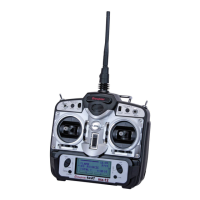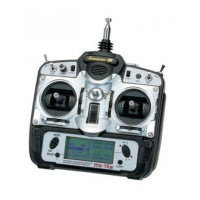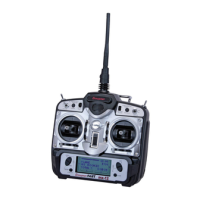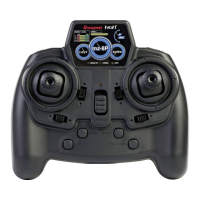96
Programming example: fi xed-wing model
First steps in programming a new model
Example: non-powered fi xed-wing model aircraft
When programming a new model you should start with
the ...
“select model” (page 44)
…, sub-menu in the »mod.mem.« menu, where you
select a vacant memory and confi rm your choice by
pressing the ENTER button or the rotary cylinder.
01
03
04
05
02
¿¿
empty
¿
¿¿
empty
¿
¿¿
empty
¿
¿¿
empty
¿
Once you have selected a free model memory, you are
immediately requested to select the type of model to be
programmed:
Sel model type
( empty mod mem )
Since in this example we are setting up a fi xed-wing
model, we simply confi rm the fi xed-wing model symbol
with ENTER or a brief press on the rotary cylinder. The
screen now reverts to the basic display.
Notes:
Naturally you can also use the pre-defi ned model •
memory 01 for programming your fi rst model; this is
the “fi xed-wing model” type by default.
Once you have called up the “Model select” option it •
is not possible to interrupt the process, i. e. you must
choose one or other model type. However, if you
make a mistake you can always correct it simply by
erasing the model memory.
If the battery voltage is too low, you will not be able •
to change model memories for safety reasons. The
screen then displays an appropriate message:
not possible now
voltage too low
Now that you have overcome this fi rst hurdle, you can
star
t programming the actual transmitter settings to suit
the model in the ...
»base sett.« (pages 46 … 49)
model name
stick mode
tail type
motor on C1
1
normal
no
… menu. At this point you can enter the “Model name”
by selecting the symbol in order to move to the
character table:
0123456789
PQRSTUVWXYZ
model name
?
:
;
ABCDEFGHIJKLMNO
GRAUB
You should also check the settings for “Stick mode” and
“motor on C1” and change them if necessary:
“no”:•
The brake system is “retracted” at the forward posi-
tion of the throttle / brake stick; in the »wing mixer«
menu the “Brake ¼ N.N.*” mixers are v.
The warning message “Throttle too high” – see page
18 or 46 … 47 – is disabled.
“no/inv”:•
The brake system is “retracted” at the back posi-
tion of the throttle / brake stick; in the »wing mixer«
menu the “Brake ¼ N.N.*” mixers are activated.
The warning message “Throttle too high” – see page
18 or 46 … 47 – is disabled.
“Throttle min. fr(ont) or re(ar)”: •
Ch 1 trim works on idle range (front or rear) only. If
the throttle stick is in the “full-throttle” direction when
you switch the transmitter on, you will be warned of
this with the message “Throttle too high”.
The “Brake ¼ N.N.*” mixers in the »wing mixer«
menu are disabled.
Note:
As mentioned previously, selecting “motor” or “no motor”
also affects the range of mixers available in the »wing
mixer« menu. For this reason we shall initially consider
“no” (no motor) in the following programming example.
In the next two lines you select the basic arrangement
of the servos in the model, and inform the transmitter of
your choice:
1
SEL
normal
stick mode
tail type
no
aile / flap 2aile
motor on C1
tail type:
“normal”, “V-tail”, “delt/FlW“ oder „2elev
sv“
aile / fl ap: 1 or 2 aileron servos and 0 or 2 fl ap
servos
* N.N. = Nomen Nominandum (name to be stated)
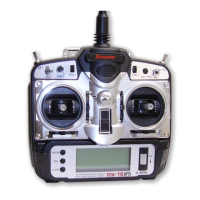
